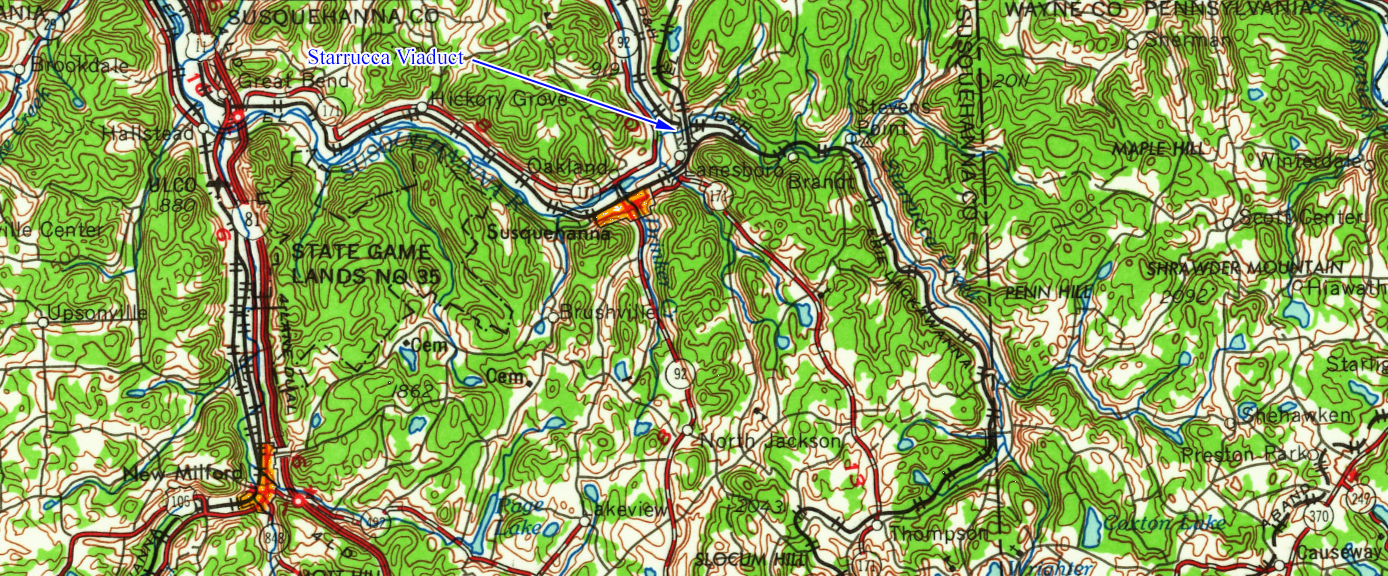Starrucca Viaduct: Completed By The NY&E (1848)
Last revised: August 24, 2024
By: Adam Burns
Starrucca Viaduct is a historic stone arch bridge which spans Starrucca Creek in Pennsylvania. Constructed in 1847-48 by the New York and Erie Railroad (NY&E), it was considered - and remains - an engineering marvel due to its size, remote location, and challenging construction.
When Starrucca was built railroads were still in their infancy. They were slowly expanding westward into the North American interior from key port cities such as Baltimore, New York, Philadelphia, Boston, and Charleston.
As a result, promoters were still developing the engineering techniques and skills required to build complicated and difficult projects like bridges and tunnels.
Starrucca was one such challenge where the NY&E (later Erie Railroad) was forced to span a valley located near what is now the small town of Lanesboro, Pennsylvania. The project - which required an unbelievable sum of money - was accommplished by a brilliant engineer and finished in just over a year.
Starrucca Viaduct - still in use today under the New York, Susquehanna & Western - is recognized as one of the oldest such bridges in Pennsylvania. It was designated a National Historic Civil Engineering Landmark in 1972. For many years, it was double-tracked as part of the Erie's New York - Chicago main line while today it only carries one track.
Photos
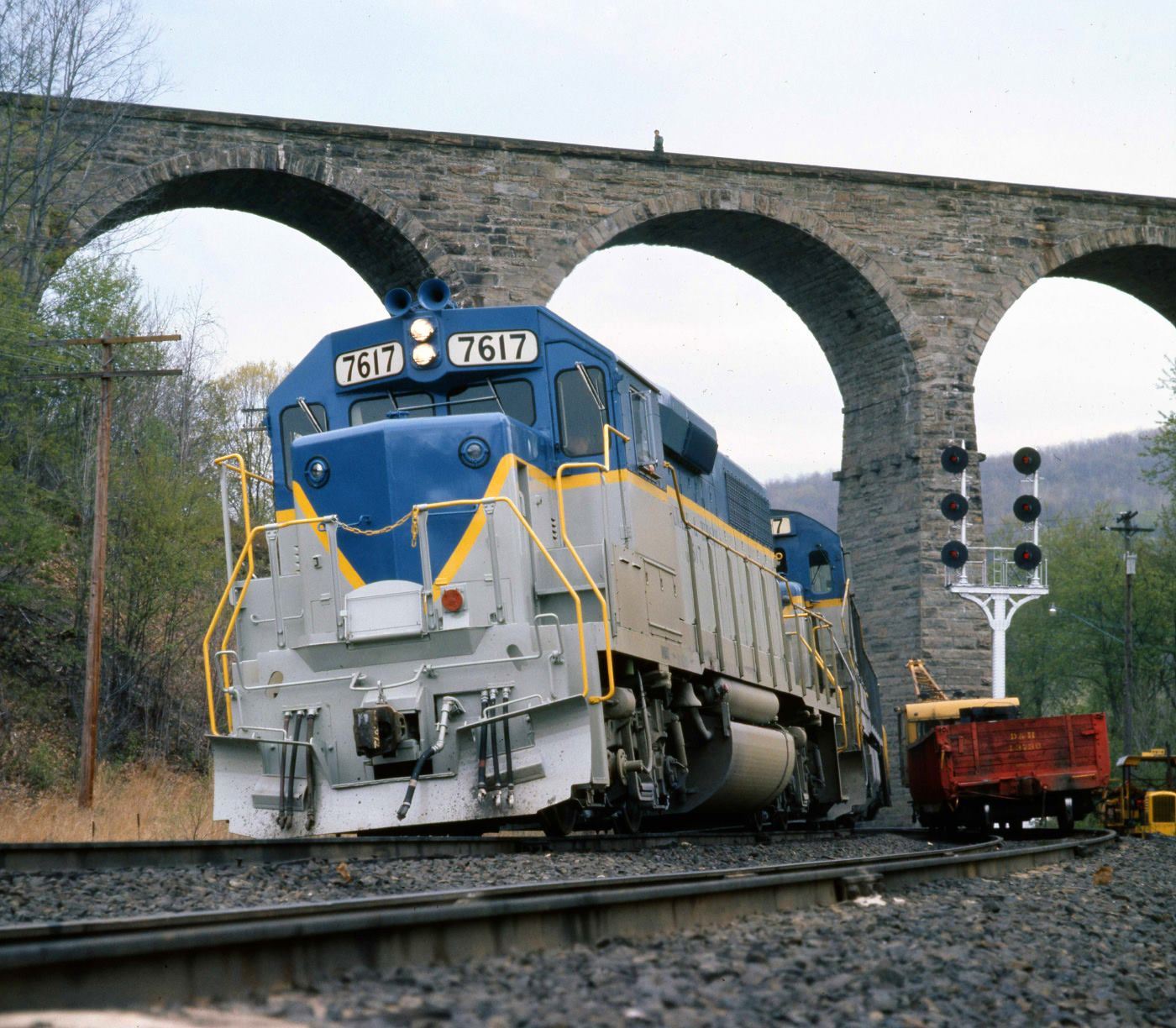 A new Delaware & Hudson GP39-2, #7617, which is still missing its nose shield, leads a northbound freight beneath historic Starrucca Viaduct at Lanesboro, Pennsylvania on the famed Penn Division (now abandoned) in May of 1976. Jerry Custer photo.
A new Delaware & Hudson GP39-2, #7617, which is still missing its nose shield, leads a northbound freight beneath historic Starrucca Viaduct at Lanesboro, Pennsylvania on the famed Penn Division (now abandoned) in May of 1976. Jerry Custer photo.History
Building its way northwest from Piermont, New York along the Hudson River, the then NY&E came across Starrucca Creek, which lay in a wide valley that spanned about a quarter-mile. At the time the New York & Erie had a near limitless supply of funds, financed by several wealthy British investors.
While money was not an issue, finding a way to practically cross the valley was a concern. With railroad engineering still in its infancy during the 1840s, few engineers knew the best method of crossing the vast expanse.
At first the railroad discussed simply creating a giant fill but decided against this due to cost and the time involved. Next, the idea of a bridge was considered although no on knew how to build a structure of such length and height.
Map
Design
NY&E's chief contractor and bridge engineer of the time, Julien W. Adams, suggested that the railroad contact James P. Kirkwood (coincidentally who was also Adams' brother-in-law), a civil engineer working for the Boston & Albany Railroad during its construction.
Kirkwood was a Scottish who had immigrated to the United States in 1834 and not only worked for the B&A but also helped to survey western railroads as well. Upon learning of the NY&E's dilemma and visiting the area Kirkwood concluded that he could indeed build the bridge, which would be a cut-stone arch design.
Construction
Almost immediately work began on what became known as Starrucca Viaduct in 1847. The stone for the bridge was ashlar bluestone, locally quarried about three miles from the site and a temporary railroad was built from the mine to the site to transport the rock.
Overall it took 800 workers (mostly of Irish descent) a little over a year to complete the bridge which priced out at $320,000, a staggering amount of money and the most expensive ever built up to that time.
Once completed, Starrucca was 1,040 feet length, 100 feet high, and 25 feet wide. In addition, it featured an impressive 17 arches spanning 50 feet each, making it a phenomenal showcase of engineering brilliance.
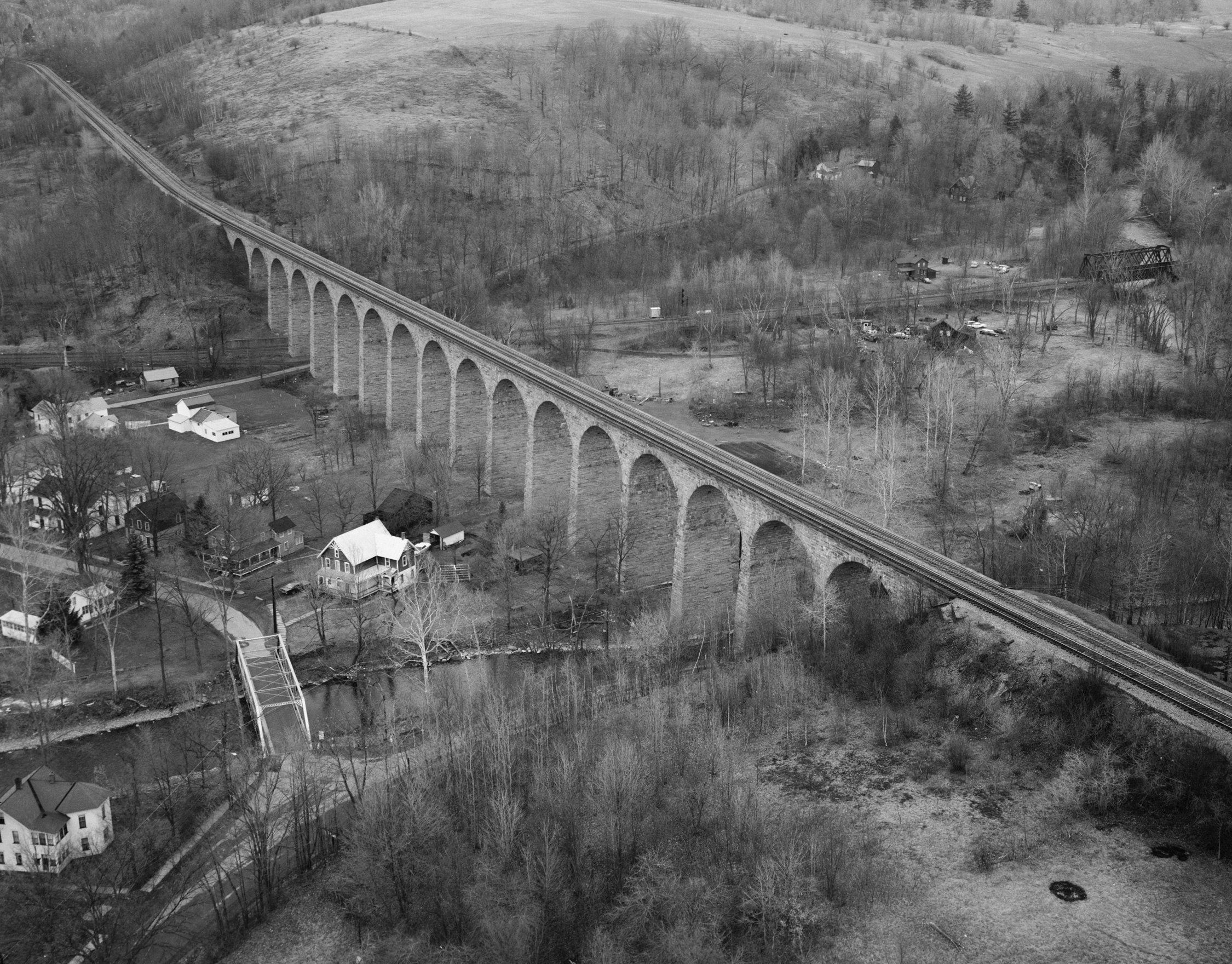 This birds-eye view of Starrucca Viaduct was taken during April of 1971 still showing the line's double-track status. Note the Delaware & Hudson's Penn Division below, also still active at this time. Jack Boucher photo.
This birds-eye view of Starrucca Viaduct was taken during April of 1971 still showing the line's double-track status. Note the Delaware & Hudson's Penn Division below, also still active at this time. Jack Boucher photo.Material
The material predominantly used in its construction was Rosendale cement and locally quarried Pennsylvania bluestone. The selected materials played a significant role in the durability and aesthetic appeal of the viaduct.
Starrucca's total cost was a staggering $320,000, a huge sum in the mid-nineteenth century, reflecting the quality and significant size of the project.
The viaduct was completed and formally opened for service on December 1, 1848, negotiating a demanding deadline and managing a daunting task that caused other projects to falter.
Over time, many railroads have owned the viaduct, including the New York and Erie Railroad, the Erie Railroad, Erie Lackawanna, Conrail, and Norfolk Southern (who currently leases it to the New York, Susquehanna and Western).
Civil Recognitions
Starrucca Viaduct was designated a National Historic Civil Engineering Landmark in 1976 and was listed on the National Register of Historic Places in 1975. These recognitions further enhance the Viaduct’s historic significance and mark its place as an iconic symbol of American civil engineering prowess.
Starrucca Viaduct is not just a technical marvel, but also an artistic masterpiece. Its cut-stone masonry display is an enduring testament to the elegant design that transcends the purely functional.
Beyond its promoter, James P. Kirkwood, the entire construction team deserves much credit. The life-risking workforce spent a relentless 800,000 man-hours throughout a harsh winter season in the completion of this iconic structure.
The viaduct stands on private railway property, and while general access isn't permitted for safety reasons, there exist several vantage points from where its architectural marvel can be appreciated.
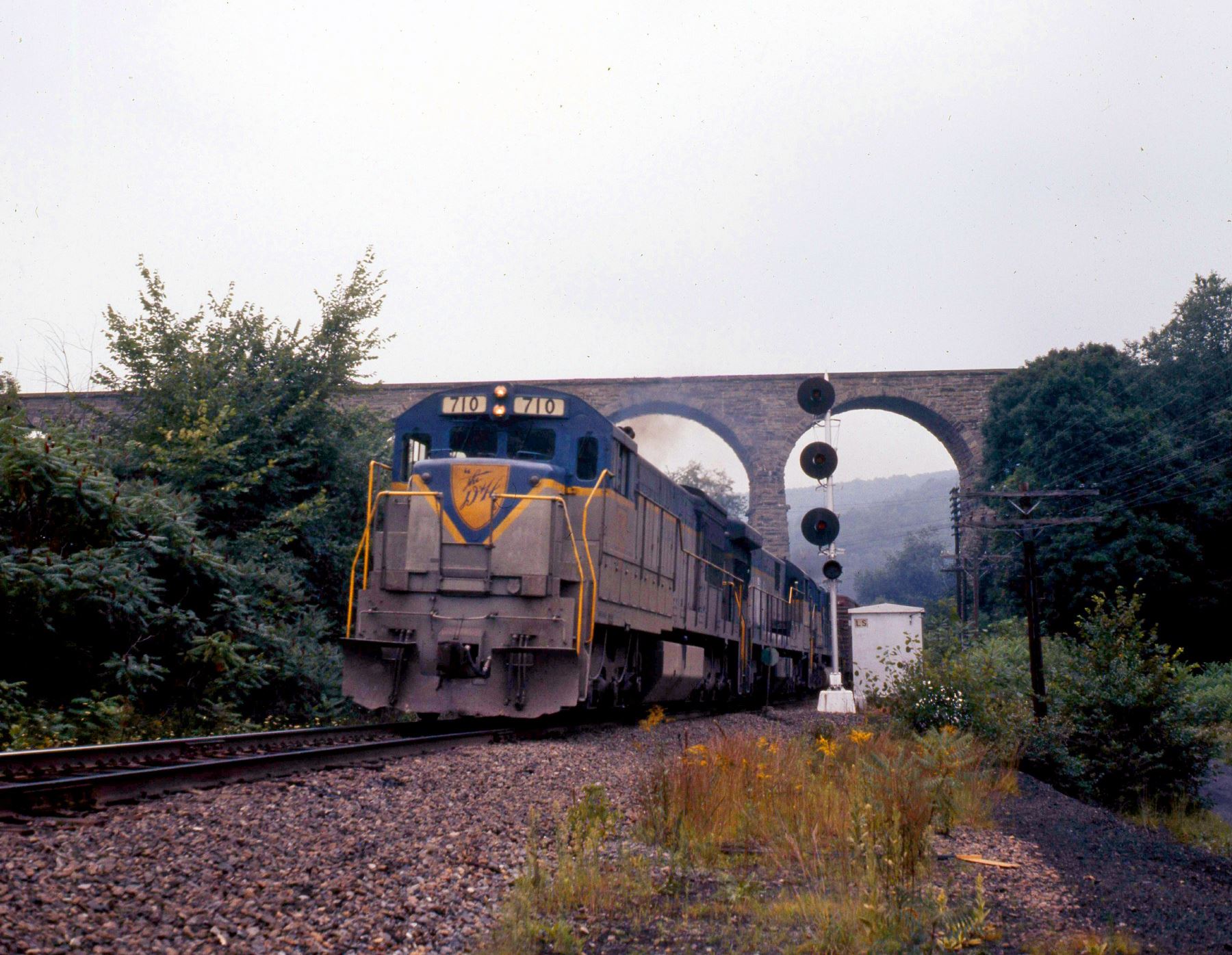 A pair of Delaware & Hudson's six-axle U-boats, and what appears to be an Alco unit, duck beneath Erie Lackawanna's Starrucca Viaduct along the now-abandoned Penn Division at Lanesboro, Pennsylvania during August of 1975. Jerry Custer photo.
A pair of Delaware & Hudson's six-axle U-boats, and what appears to be an Alco unit, duck beneath Erie Lackawanna's Starrucca Viaduct along the now-abandoned Penn Division at Lanesboro, Pennsylvania during August of 1975. Jerry Custer photo.Today
The double-tracked bridge remained in regular use through the
Erie's merger with the Delaware, Lackawanna & Western to form the
Erie Lackawanna. When the EL became part of Conrail the new company
continued to use the bridge until it came under Norfolk Southern control
in June, 1999.
NS has since leased this section of the former Erie to
the New York, Susquehanna & Western Railway and the bridge continues
to see regular use today, more than 170 years since it was completed.
Specifications
Length - 1,040 Feet
Height - 100 Feet
Deck - 25 Feet To Accommodate Two Tracks
17 Arches At 50 Feet In Length
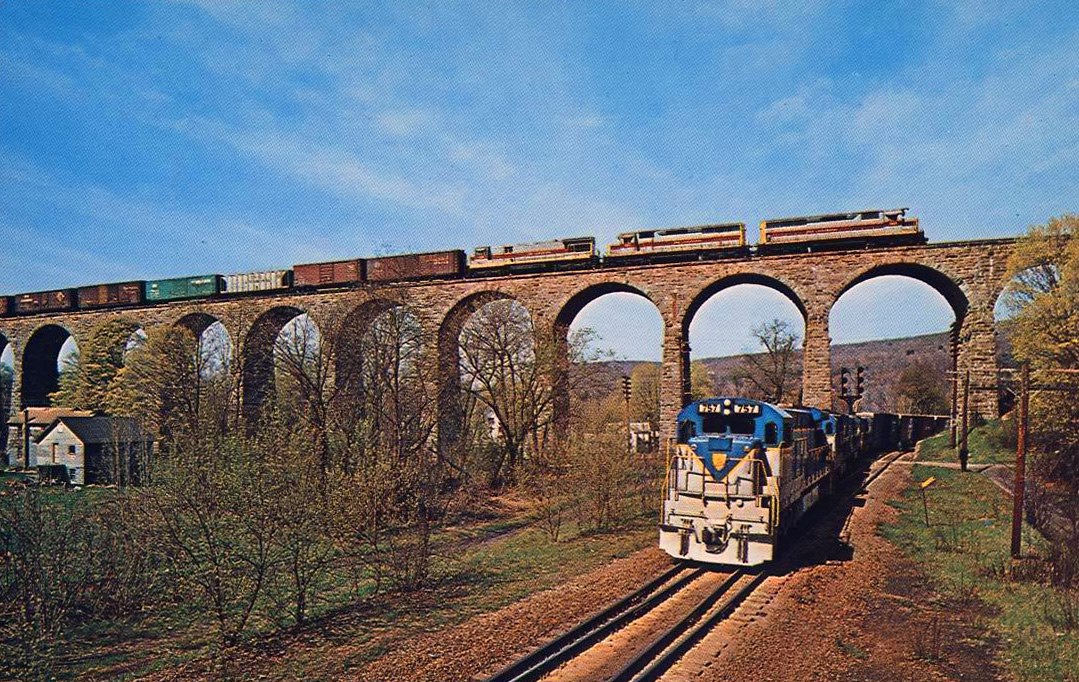 Those were the days... A Delaware & Hudson freight is on the fabled Penn Division as an Erie-Lackawanna counterpart passes overhead on historic Starrucca Viaduct at Lanesboro, Pennsylvania during the 1970s. Today, both roads are gone and only the viaduct still carries rails. Jim Shaughnessy photo.
Those were the days... A Delaware & Hudson freight is on the fabled Penn Division as an Erie-Lackawanna counterpart passes overhead on historic Starrucca Viaduct at Lanesboro, Pennsylvania during the 1970s. Today, both roads are gone and only the viaduct still carries rails. Jim Shaughnessy photo.Penn Division
When the Jefferson Railroad opened in 1872, connecting Carbondale, Pennsylvania with the Erie's main line at Lanesboro, operations here become much more interesting. The little road had been chartered in 1864 and was entirely funded by the Erie.
Delaware & Hudson gained trackage rights over the route as an important through connection to Wilkes-Barre and Scranton. While it was difficult to operate with stiff grades and sharp curves it provided interchange with many of the fabled anthracite roads.
The line became part of the the D&H's famous Penn Division and Lanesboro offered a fabulous location to catch meets between Erie/Erie Lackawanna and D&H trains, as the latter passed beneath the former's Starrucca Viaduct.
Unfortunately, this all ended in the 1980s when the D&H purchased the former Lackawanna's Scranton-to-Binghamton mainline and diverted all traffic off the Penn in 1982.
Legacy
The Viaduct has withstood great floods, harsh winters, and the test of time. This robust structure attributes its longevity largely to the extraordinary effort put into its maintenance by the various owners.
Over the years, minor improvements and necessary repairs have kept the Viaduct in excellent shape. However, the original architectural integrity was preserved which continues to captivate onlookers.
For train enthusiasts and tourists alike, the Starrucca Viaduct is a unique spectacle. The sight of a modern train chugging through the historic structure forms a harmonious union of the past and the present.
This triumph of engineering will undoubtedly continue to be cherished and preserved for future generations, owing largely to its historic significance and the audacious display of civil engineering prowess that it represents.
In closing, the Starrucca Viaduct is an iconic testament to human ingenuity, tenacity and grandeur. A standing symbol of the railway age, it bears witness to an era gone by and remains an integral part of the historic landscape of the United States.
Contents
Recent Articles
-
An Alabama Christmas Train Ride In Huntsville!
Oct 31, 25 11:10 PM
The Santa Train and the North Star Limited each offer their own style of holiday magic, drawing families from across North Alabama and beyond to experience the simple joy of rail travel wrapped in twi… -
A Washington Christmas Train Ride On The Santa Train!
Oct 31, 25 01:45 PM
Tucked into the forested foothills of north Clark County, Washington, the Chelatchie Prairie Railroad offers a charming blend of Pacific Northwest scenery, living history, and small-town hospitality. -
A Wisconsin Christmas Train Ride In East Troy!
Oct 31, 25 01:37 PM
When the holidays arrive, the museum becomes a festive favorite thanks to its Christmas Trains, a family tradition that pairs small-town warmth with the magic of an old-fashioned trolley ride.

